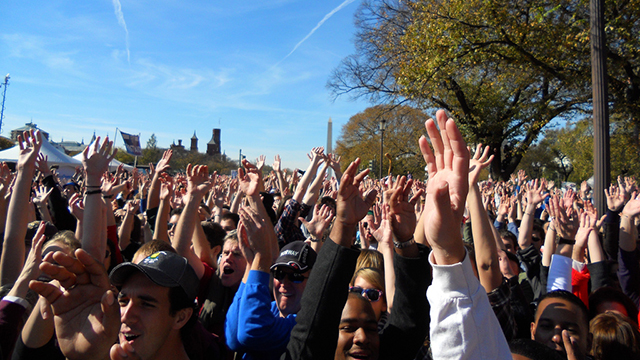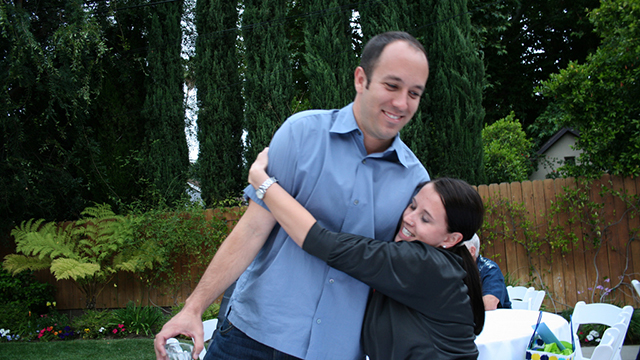Body language is a huge part of how we communicate with other people. However, most of us only have an intuitive knowledge of non-verbal communication at best. Fortunately, if reading body language doesn’t come naturally to you, or if you’d simply like to get better at it, there’s a huge body of work that details what the body is really saying.
Pictures: Ace Armstrong, Nico Paix, Jason Ippolito, DJ Bass
Read Body Language Through the Comfort/Discomfort Lens
For a lot of people, diving into the world of body language elicits the same reaction: “At last, I’ll learn how to be a human lie detector!” It’s hard to blame anyone for the impulse. However, contrary to what Cal Lightman would like us to believe, you can’t tell exactly how a person is feeling just because their lip twitched or they crossed their arms. What you can do is gauge how much a person is comfortable. This comfort/discomfort spectrum is far more important than trying to identify a specific expression or guessing a particular thought in someone’s head.
As Joe Navarro — a former FBI interrogator and expert in body language analysis and research — explains in his book What Every BODY is Saying:
Those who are lying or are guilty and must carry the knowledge of their lies and/or crimes with them find it difficult to achieve comfort, and their tension and distress may be readily observed. Attempting to disguise their guilt or deception places a very distressing cognitive load on them as they struggle to fabricate answers to what would otherwise be simple questions (DePaulo et al., 1985, 323 — 370). The more comfortable a person is when speaking with us, the easier it will be to detect the critical nonverbals of discomfort associated with deception. Your goal is to establish high comfort during the early part of any interaction or during “rapport building.” This helps you to establish a baseline of behaviours during that period when the person, hopefully, does not feel threatened.
While he describes this dynamic in the context of lie-detection, it’s the lens through which all body language can be interpreted. If you’re at a party and everyone’s enjoying themselves, a person in a chair, with their arms folded, and head down will stand out. They might seem uncomfortable and you might wonder if something is out of the ordinary. In response to this, you might ask if anything is wrong. That very same set of actions observed in someone in a hospital waiting room would be much less abnormal. Even if the person has nothing to worry about, hospitals can make people uncomfortable or nervous. Asking this person what’s wrong could easily result in the very obvious reaction: “I’m in a hospital.”
Observing how comfortable a person is in a particular context can give you clues as to how they feel. If you’re on a first date and your partner seems comfortable, they’re probably into you! If you’re conducting a job interview and the applicant seems comfortable and confident during the process, but gets fidgety and nervous when you ask if they have stolen from previous employers, it might be something to inquire about further. Body language is not an exact science, but gauging comfort levels can give you clues about what’s really going on in the minds of people around you.
The Basic Body Cues to Watch For
Most of our body parts are quietly communicating how we feel and what we want, whether we realise it or not. The following are some cues you can watch for to get an idea of how a person is feeling, but keep in mind the comfort/discomfort paradigm. No one behaviour tells the whole story.
Head and Face

The first thing to understand about trying to read facial expressions is that they are not always the most honest. We’ll get to which body part is the most honest later, but we are trained from a very young age that certain facial expressions and actions are appropriate for certain occasions, whether we feel them or not. However, there are still some cues you can glean from facial expressions.
One of the easiest to learn about (although still one of the hardest to accurately identify) is the “fake smile”. As the Paul Ekman International blog (named for the pioneer in facial expression analysis Paul Ekman) explains, fake smiles — the kind we make because we’re supposed to — are most often done with just the mouth. We know to raise the corners of our mouths to smile. A lot fewer of us are aware of how much our eyes are involved in a proper smile. In a real smile, our eyebrows, eyelids, and sometimes even our whole head turn upwards, along with the corners of our mouths. This test from the BBC can let you try your hand at telling the real smiles from the fake ones.
Pursed lips are another way to tell when someone is drifting over to the discomfort side of the spectrum. This is a favourite expression analysts like to point out whenever a politician is giving some form of confession. In cases like Anthony Weiner and Eliot Spitzer’s confession speeches, both can be seen tightening their lips, pursing them to the point they nearly disappear.
These are just a couple of easy to identify facial gestures that can tell you a bit about what a person’s feeling, but there are so many different variations that the face itself has its own coding system to gauge them all. And, as we’ve established, the face isn’t always the most honest part of the body, which is why it’s important to give equal (or more) attention to the rest of the body.
Arms

Our arms are heavily employed in self-expression. Many individual gestures can be taught or trained in us over time (such as “don’t point at people”), but there are two more helpful aspects of arm and hand motion to observe: how much space they take up, and how high they reach.
Gravity-defying gestures, in any part of the body, are generally seen as positive. When we’re happy, excited, or interested, we raise our heads or our chin, our arms go up, even our legs and feet start to point skyward or bounce if we’re sitting. The arms are incredibly versatile at highlighting this behaviour. As Navarro explains again:
When excited, we don’t restrict our arm movements; in fact our natural tendency is to defy gravity and raise our arms high above our heads. When people are truly energized and happy, their arm motions defy gravity. As previously mentioned, gravity-defying behaviours are associated with positive feelings. When a person feels good or confident, he swings his arms affirmatively, such as while walking. It is the insecure person who subconsciously restrains his arms, seemingly unable to defy the weight of gravity.
Candidly tell a colleague about a drastic and costly mistake she just made at work and her shoulders and arms will sink down and droop. Ever have that “sinking feeling”? It’s a limbic response to a negative event. Negative emotions bring us down physically. Not only are these limbic responses honest, but they happen in real time. We leap and thrust our arms in the air the moment the point is scored, or our shoulders and arms sink when a referee rules against us. These gravity-related behaviours communicate emotions accurately and at the precise moment we are affected. Further, these physical manifestations can be contagious, whether at a football stadium, a rock concert, or in a gathering of great friends.
Individual gestures of the hands may be helpful for communicating conscious thoughts — like a coach speaking in a non-verbal code to a player on the field — but when it comes to gauging the subconscious mood or comfort level of a person, gravity is where it’s at.
Torso

Our torso — comprised of our shoulders, chest and belly — is pretty vital to our survival. That’s where our organs live! As such, we’re well-trained to protect this part of our body instinctively. Even in regular social settings, we protect our torso. More importantly, we allow access to our torso when we’re comfortable:
These torso displays that reflect the limbic brain’s need to distance and avoid are very good indicators of true sentiments. When one person in a relationship feels that something is wrong with the way things are going, he or she is most likely sensing a subtle degree of physical distancing in his or her partner. The distancing can also take the form of what I call ventral denial. Our ventral (front) side, where our eyes, mouth, chest, breasts, genitals, etc. are located, is very sensitive to things we like and dislike. When things are good, we expose our ventral sides toward what we favour, including those people who make us feel good. When things go wrong, relationships change, or even when topics are discussed that we disfavor, we will engage in ventral denial, by shifting or turning away. The ventral side is the most vulnerable side of the body, so the limbic brain has an inherent need to protect it from the things that hurt or bother us. This is the reason, for example, we immediately and subconsciously begin to turn slightly to the side when someone we dislike approaches us at a party. When it comes to courtship, an increase in ventral denial is one of the best indicators that the relationship is in trouble.
This behaviour of either sharing or denying our ventral side to people can be most readily observed in a dating or romantic context. Early on in a relationship, a couple will frequently angle their torso more towards their partner than away. They will turn towards them when they enter a room, or lean in when sitting next to each other.
Part of the reason we do this is because when we’re comfortable, our limbic system lowers its defences. We protect or deny access to our torso when we’re around unpleasant things. Naturally, the converse is usually true. If we’re readily leaving our chests and abdomen open, even voluntarily pointing them towards a person, it probably means we feel happy and safe with what’s going on.
Legs

If you had to guess which part of the body is the most honest, most people would guess that it’s eyes or possibly the face as a whole. In reality, we’re way off. The legs and feet, suggests Navarro, are where the real honesty lies. After all, we’re trained throughout most of our life to smile for the camera, stop making faces and to pretend to have a good time. However, millions of years of evolution have taught us that our legs need to be ready to escape.
One key way to detect the leg’s intention is to notice where the feet and legs are pointing. Similar to the way we point our chests, our lower extremities tend to lean or point in the direction of where we’d like to go or what we’re most interested in:
When two people talk to each other, they normally speak toe to toe. If, however, one of the individuals turns his feet slightly away or repeatedly moves one foot in an outward direction (in an L formation with one foot toward you and one away from you), you can be assured he wants to take leave or wishes he were somewhere else. This type of foot behaviour is another example of an intention cue (Givens, 2005, 60 — 61). The person’s torso may remain facing you out of social diligence, but the feet may more honestly reflect the limbic brain’s need or desire to escape.
On the flip side, crossed legs — particularly while standing — are a relatively strong indicator that a person is interested in staying where they are. This is tied pretty deeply into our survival instinct. While we may pretend to be having a good time, crossing the legs makes it more difficult to escape danger. Even if we might know that there’s no immediate physical danger at a social gathering we want to leave, our brains still respond to the discomfort in the same way: by preparing to move away from here.
The Importance of a Baseline
More than any other individual piece of body language is the importance of establishing a baseline. Everyone has their own quirks, habits and idiosyncrasies. A shy person may keep their arms lower and closer to their body and their head down more than a more outgoing person by default (which is part of the reason why an introvert can be misinterpreted as being upset or confrontational). Any one behaviour by itself is not necessarily indicative of a mood change. However, as you get to know a person and how they behave in normal situations, abnormal behaviour can give you a much greater indication of how they’re feeling. Don’t just watch for a foot bouncing or a head held high. Keep an eye out for when that behaviour is out of the ordinary.
More importantly, use the cues available to you to gauge comfort levels and be aware of what the person is reacting to. Often, you don’t need to perform a deep line of questioning to figure out what’s really on a person’s mind. If they grimace when a particular song comes on when they’re otherwise happy, it’s a pretty safe bet that the song was the cause.

Comments
One response to “How To Read Body Language More Effectively”
If you’re at a party talking with a bunch of girls, look at their feet to see if any are pointing towards you 😉 If so you’re half way there.
Also take into account the other body language signals like women playing with their hair and also showing you their wrist.